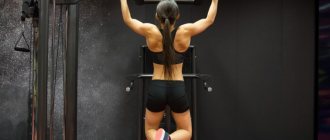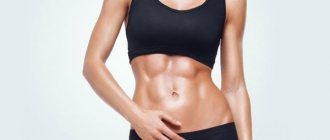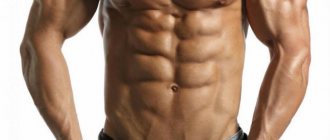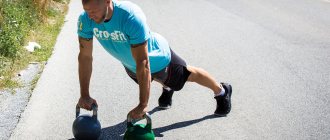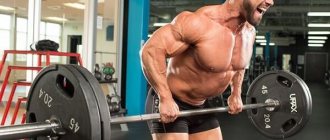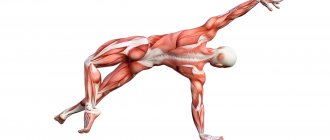How to build muscles at home. Basic Rules
By the way, in the first year of my classes, I also trained at home for a long time. Without any special knowledge, to be honest, nevertheless, it was possible to achieve at least some, albeit not very pronounced, result.
Our muscles don't care where they get the load. Muscle growth does not start because of the atmosphere in the gym, but if you follow just a few simple rules.
- PROGRESSIVE LOAD (in order for muscles to adapt and grow, it is necessary to constantly increase the load).
- QUALITY RECOVERY (fractional meals 6-12 times a day + 8-10 hours of sleep DAILY).
- DEVELOPED MUSCLE SENSE (you must strive to complicate your work, skillfully directing the load exactly to the target muscles).
These are the basic rules, if followed, your body will grow.
There are some other specific points that we will talk about a little later, but this is the BASIC!
I have a very cool article on my blog for girls and men about how to build muscles. There you can learn how to pump up from scratch.
Let's go over the above rules.
Let's start, perhaps, with the progression of the load.
Progressive load
This point is very important, but despite this, for some reason many athletes (not just beginners) successfully ignore it, remaining unchanged for a long time.
We must remember that muscle growth is an EXTREMELY UNBENEFITABLE process for our body, because... An increase in muscle volume certainly leads to an increase in energy expenditure.
That is why, at first, the body does not rush to increase muscle mass. First, it transforms the central nervous system, endocrine system, ligamentous apparatus, nutrient storage system, etc.
Only when the load continues to grow, and the body can no longer delay muscle growth (all systems are transformed and are not able to “digest” the load themselves), does it begin to give up. In a good way again.
What I mean is that this is when muscle growth begins.
Nothing is done in our body just like that. The body does not do what is unprofitable for it, because... constantly strives for homeostasis (balance).
In order for the body to benefit from increasing muscle mass, it is necessary to give an ever-increasing load . The body understands that this is beneficial, because... It will be easier for him to digest such a load when it is repeated.
By the way, in my opinion, it is the progressive load that is most difficult to achieve at home.
Everything is simple in the hall. If a given weight becomes too light for you, then you simply add a little more. That's all.
At home, everything is not so simple, especially if there is no minimum necessary equipment. We’ll talk about what’s best to have on hand at home a little later.
At home it is difficult to ensure a proper constant progression of the load, but it is possible, at least at the initial stage.
High-quality restoration
High-quality recovery is something that many people lack, not just those who train in the gym.
Muscles grow not during training, but during RECOVERY! To the extent that your recovery is complete, you will grow.
It often happens that a person trains well, is disciplined, does not miss training, but does not grow, or generally becomes smaller and feels worse.
What could be the problem? 99% in POOR RECOVERY!
With proper, balanced nutrition, the body receives all the necessary materials for the construction of new protein structures.
This process is called ANABOLISM.
The fact is that our body can be in several states:
- Catabolism (nutrition and sleep are insufficient, protein and other structures are destroyed). This can also happen during heavy training.
- Homeostasis (there is enough nutrition and sleep, enough recovery abilities to stop damage during training, the body remains unchanged).
- Anabolism (enough nutrition and sleep + growth of protein and other structures occurs).
It is conditionally IMPOSSIBLE to achieve anabolism and catabolism at the same time (only with the use of anabolic steroids, restructuring of the hormonal system in adolescence, the return of former achievements).
Most people, like you and me, need to first understand whether we are drying out our body or gaining weight.
This article is about gaining muscle mass, so let’s assume that we are gaining weight. What do we need to do?
First of all, we must get a little more calories than we spend! Many people wonder why they are not growing, although most of them do not take into account their limited diet (eating little) and their fast metabolism.
In order to start growing (enter a state of anabolism), one of the most important conditions is to take into account the quantity and quality of your nutrition.
There is a very simple way to control your nutrition.
Just start eating almost the same foods in the same quantities every day. This way you will be sure that you ate no less food necessary for growth than yesterday.
“On the mass” it is very important to control the intake of complex carbohydrates (and not proteins, as sports nutrition manufacturers shout on every corner).
I usually prefer buckwheat due to its low glycemic index.
Glycemic index (GI) is a kind of QUANTITATIVE INDICATOR of the absorption of carbohydrates.
This is a QUANTITATIVE indicator, NOT A SPEED indicator! The speed will be the same for everyone (the peak will be in about 30 minutes for both sugar and buckwheat), but the AMOUNT of glucose will be different!!!
Simply put, different foods have DIFFERENT abilities to raise blood sugar (hyperglycemic potential) and therefore have different glycemic indexes.
Gradually increase the amount of food you eat. Controlling the process is very simple:
- If you are growing, but the amount of fat does not remain, then you are on the right track, keep up the good work.
- If you are growing, but at the same time the amount of fat is increasing (folds, double chin, sides have appeared), then it’s time to reduce the number of calories. You have a strong excess.
- If you are not growing, then gradually increase the amount of calories.
This is very approximate and figurative, friends. I hope you understand this.
Over time, you will find your working dosage (for example, two glasses of buckwheat, 6 eggs and 400 g of breast per day).
Recovery also includes the quality and quantity of sleep!
During sleep, amazing metamorphoses occur in the body (especially during adolescence). The entire system is recharged.
The hormones necessary for growth and recovery (testosterone, growth hormone, etc.) are released.
Try to go to bed no later than 22-23 hours and sleep at least 8-10 hours a day.
Developed muscle sense
I wrote a whole article about this.
To put it briefly, muscle feeling is the state when you hit the target muscle with a load at each point of the amplitude.
In other words, you don't "release" the load at any point.
In order to begin to better understand the exercise technique and feel your muscles better, you can perform simple, imaginary exercises without any weight before going to bed.
For example, you lie down on the bed and imagine how you remove an imaginary barbell from the racks and begin to press it. While performing fictitious movements, you will be able to understand how your limbs move while moving the “bar”.
Some time will pass, and your technique in the gym will become ideal.
Proper nutrition
Knowing how to quickly build muscle at home, you should understand that nothing will work without proper nutrition. Muscle mass will increase, but under a layer of fat, accordingly, instead of a beautiful relief, a person will receive an increase in overall volume. To succeed, you need to reconsider your diet. In general, in sports, 70% of the result depends on nutrition, and only 30% comes from training. The basic principles are as follows.
- Daily calorie content. It will have to be calculated using a special formula, since it depends on the initial parameters. The average value is 2000 kcal per day. If a person wants to lose weight, this amount should be reduced by 15-20%. To gain muscle mass, you need to add another 300-500 kcal of food to your daily diet, but this amount should be gained from easily digestible protein (chicken breast, egg whites, sports protein).
- Nutrients. An important criterion for proper nutrition is the balance between proteins, fats and carbohydrates (BJU). Here again, everything is individual and there are different formulas for calculating the amount of nutrients. On average, it is recommended to consume 1 g of protein, 1 g of fat and 2 g of carbohydrates for every kilogram of weight. Athletes who want to increase muscle size need to increase the amount of protein to 1.5 g, respectively, reduce the amount of fat and carbohydrates. For those who want to lose weight, it is recommended to cut the intake of fats and carbohydrates by 20%, and leave the amount of protein unchanged.
- Water. The body needs water, especially during intense exercise. The recommended intake per day is 1.5-2 liters, to which you also need to add at least 700 ml of clean water during training.
By adhering to these rules and practicing regularly, everyone will achieve their goal. You can evaluate the results after 3-4 weeks of regular exercise.
The main problem with home training
As I said, the main problem with home training of ANY MUSCLE is PROGRESSION OF THE LOAD!
The fact is that it needs to be constantly increased.
In the gym, such a problem simply does not exist, because... if the current weight becomes too light for you, then you simply hang a couple more small “pancakes” on the barbell and you’re done. Or take heavier dumbbells.
At home, this problem is especially acute.
I remember using water bottles etc to increase the load. All this is not very convenient, so I would like to advise you on minimal equipment to make your training much more interesting.
What equipment is best to have at home to train?
The first, and probably the most important thing is a COLLAPSIBLE PAIR OF GENTELS (from 5 to 40 kg each).
I only have dumbbells at home, 20 kg each. I no longer have enough of this, but from the very beginning it was more than enough for me.
You will have the opportunity to perform a wide variety of exercises. We'll talk about them later.
Following.
Bars ! They are extremely inexpensive, and if you have the opportunity, it is better to buy them. The effect they produce is amazing.
With their help you can pump up your chest, triceps, abs, back, etc.
The parallel bars can be replaced with two chairs, between the backs of which you can do push-ups. Just be careful! Don't break yourself this way.
The third thing is optional, but can make your life much easier - this is a HEIGHT ADJUSTABLE BENCH !
I don’t have one at home, but if I did, it would significantly increase the range of possible exercises.
So, you need:
- Collapsible dumbbells (from 5 to 40 kg)
- Bars.
- Bench with variable inclination angle.
If it were possible to choose only one item, then I would choose collapsible dumbbells.
They give us a huge selection of different exercises that we can do at home.
How to pump up at home. Basic exercises for home workouts
I will list just a few exercises that everyone can do at home:
- Squats.
- Deadlift with dumbbells.
- Pull-ups.
- One-arm dumbbell row.
- Shrugs with dumbbells.
- Dumbbell press on an incline bench or on stools.
- Dips (between chairs).
- Lying dumbbell flyes (on a bench or stools).
- Pullover with a dumbbell.
- Seated dumbbell press.
- Dumbbell row to the chin.
- Bent over dumbbell swings.
- Arm extensions with dumbbells behind the head.
- French press.
- Lifting dumbbells for biceps.
- Standing hammers.
- Reverse grip dumbbell curls.
- Standing calf raise.
- Press crunches.
- Reverse abdominal crunches.
And this, friends, as you understand, is not a complete list. This is just the first thing that came to my mind.
There is nothing new in the technique of performing these exercises, so you can easily read about it in the following articles:
- An article about squats and how to pump your legs.
- About how to pump up your back.
- About the trapezoid.
- How to pump up your breasts at home.
- How to pump your shoulders.
- How to pump up your arms.
- How to quickly pump up your abs at home.
The above articles have everything about the correct exercise technique.
Now, let's move on to the most interesting part. To the most practical scheme. I think you are wondering in what order and how to do this whole thing.
As always, I will give more than one typical scheme, because... I know very well that all people are individual, and several schemes are for different people.
The schemes will be mainly designed for beginners, because... Any more or less serious athlete will most likely still go to the gym after the preparatory period.
The best exercises to get pumped up at home
We recommend that you read the article: how to gain muscle mass at home, from it you will learn how to eat properly, exercise and what you need to do to increase muscle mass.
Upper body and abdominal exercises

Push ups
To work your arms and chest, do push-ups - this is the alpha and omega of home workouts. To get the most out of them, make sure you perform the movement correctly. The back should be straight and in line with the pelvis, the pelvis should not sag. In general, the palms should be approximately shoulder-width apart, but to emphasize the chest, you can place them a little wider, and to emphasize the arms, a little narrower. Additionally, mix negative and positive incline push-ups for better muscle growth.
- Positive incline push-ups work different areas of the muscles. To perform them, simply rest not on the floor, but, say, on an armchair or coffee table.
- For negative incline push-ups, place your feet 1-2 feet (0.30-0.61 m) above the point of support and perform a regular push-up. Remember to keep your head slightly raised and your back straight.
- Each set should consist of eight to twelve repetitions. Try to do three approaches, a man can do it.
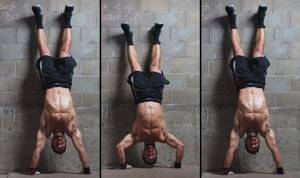
Wall push-ups
To work your shoulders and back, do push-ups on your hands against a wall. And although this exercise is not for the faint of heart, it nevertheless works great on many different muscles. To get into the right position, lie on your back against a wall. Place your hands on the floor and slowly “walk” up. From the top position, touch your feet to the wall for balance, slowly lower until your head touches the floor and return to the starting position to complete the repetition. Try to do three sets of ten reps.
- If you're nervous about doing this exercise, you can cheat a little and use a high table. Place your feet on the tabletop so that your hips and torso remain in the air, and place your hands on the floor. When doing push-ups, make sure your head is pointing strictly vertically down. This exercise is sometimes called corner push-ups.

Triceps push-ups
To work your arms, do dips or you can use a chair. A stable bench, table or chair approximately 1-2 feet (0.3-0.6 m) high will be suitable as a replacement for the bars. Place your hands on the bench behind your body, your pelvis should be in the air, your knees bent 90 degrees. Place your feet firmly on the floor and lower your pelvis until your arms are bent at about 90 degrees. Push back to the starting position. Perform three sets of 15-20 repetitions.
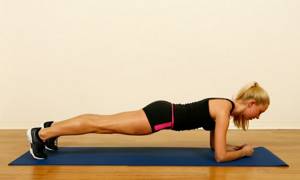
Plank
Planks are a great way to tone your muscles at home, strengthen your core, and are easy to modify to add more challenge to the exercise. To perform a plank, take a lying position. However, instead of resting on your palms, lower yourself onto your elbows. Tighten your gluteal muscles, straighten your back - the line between the base of your neck and the base of your pelvis should be completely straight. Hold this position for a minute, rest and repeat two more times.
- A side plank is where you stand on your side, resting on your elbow and the outside of your leg. Again, keep your back straight and focus on not sagging your pelvis.
- Plank push-ups: Start by lying down, palms shoulder-width apart, feet hip-width apart. Lower yourself onto your elbows into an elbow plank position, then rise back up into a prone position. Perform 12 reps in each set.
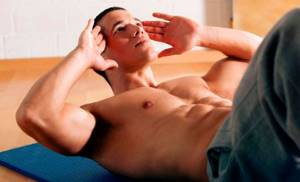
Ab crunches
To strengthen your abdominal and core muscles, do crunches. Crunches have been and remain the best exercises, so don't neglect them. Lie on your back, bend your knees and place your feet on the floor. Place your hands behind your head and lift your shoulders 6-8 inches (15-20 cm) above the floor, pause for a second, then slowly lower back. Immediately bend over again, keeping your eyes focused on the ceiling and your movements slow and deliberate. Try to do three sets of eight to twelve repetitions.
- Straight Leg Raise: Lie on your back with your legs completely straight, arms extended towards the ceiling and lift, keeping your legs straight. Stretch your arms and try to touch your toes, then slowly lie back to the starting position. Complete 10 reps.
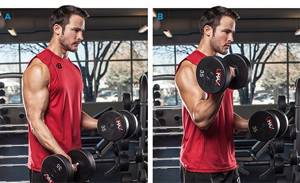
For the simplest curls, use a bottle of water, a heavy book, or buy dumbbells. While other exercises require little or no additional equipment, most upper body workouts still require weights or resistance to be effective. Take a weight that is comfortable for you and try
- Biceps Curl
- Triceps extension
- Shoulder raises
- Craving for the lower back
Exercises for the muscles of the lower body
To work your leg muscles, do intense explosive cardio-style movements. And while most people don't associate muscle growth with cardio exercise, there are plenty of moves you can perform that will give you strong, toned legs. Choose 5-6 exercises and perform each for 60 seconds. Rest for 30 seconds, then move on to the next one. After you complete all six exercises, rest for 4-5 minutes and repeat 2-3 more times. Your legs will be on fire, but this way you will quickly tone them up.
Leg exercises:
- Jumping with arms swinging to the sides;
- Lunges;
- Burpee - perform a jump with arm swings, fall into a prone position. Repeat;
- Jumping Knees - Jump quickly with each leg in turn, raising your knee as high as possible. Try to keep the time of contact with the floor to a minimum:
- Side Jumps - Jump to the side, land on one leg bent at the knee, then explosively jump onto the other leg;
- Twisting the body;
- Box jumps or simple plyometric exercises.
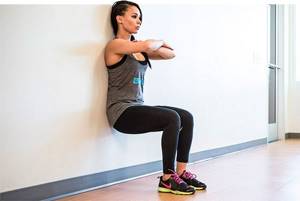
Wall Squats
Rest your back against the wall and “sit” so that your knees are bent at 90 degrees and your pelvis is hanging in the air, as if you were in a chair. Hold this position for one minute. Rest for thirty seconds and repeat two more times.

Body weight squats
This is one of the best ways to pump yourself up. To perform a squat, stand with your feet hip-width apart, straighten your back, lift your head, and tighten your abs. Place your hands on your hips or extend them out in front of you, whichever is more comfortable for you. Squat down as if you were sitting in a chair. Your back should be kept straight, your knees should be directly above your toes, and they should not protrude forward. Focus on sinking your pelvis. Perform 10 times, then do two more sets after a short rest.
- Bulgarian split squat: Place your front foot on the floor and place your back foot on a raised platform, such as a coffee table or chair. Lower yourself into a squat, then return to the starting position. You can spread your arms out for balance or rest them on your hips. Do 12 reps on each leg.
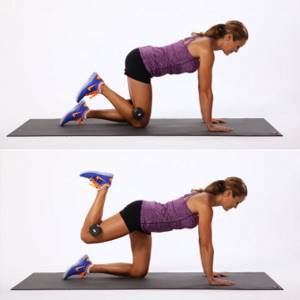
Swing your leg up while standing on all fours . Get down on your hands and knees and lift one leg back and up, keeping your knee bent at a 90-degree angle. Do 12 reps on each leg.
Gluteal bridge
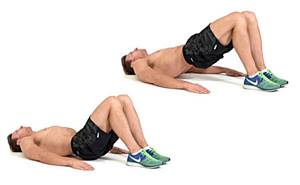
Lie on your back, bend your knees, and place your feet on the floor. Raise your pelvis so that your body forms something like a bridge. Raise your left leg in a high pelvic position, then lower it and repeat with your right leg. Perform 10 repetitions on each leg.

Lunges
Lunges are a great way to work your glutes, thighs, and hamstrings. To perform this movement, step approximately 3-4 feet (0.9-1 m) in front of you. The leg should be bent at the knee about 90 degrees. Lower your pelvis, the knee of the front leg should be above the toe, the back leg bent at the knee should almost touch the floor. Push off and step with your other leg to complete the rep. Perform 10 times on each side, then rest and do 2 more sets.
- If you have dumbbells or other weights, you can make this exercise heavier and thereby significantly increase its effectiveness. Even just a bottle in each hand is good.
How to build muscles at home. PRACTICAL SCHEME
Variations, as you understand, can be very different. I won’t try to be original by coming up with various crazy options for exercises, but I will give those that are most likely to work great for you.
Scheme for a green beginner:
- Squats (body weight): 3 x max
- One-arm dumbbell row : 3 x 10-15 (each arm).
- Push-ups : 3 x max
- Press crunches : 3 x max
Believe me, friends, if you have never exercised before, then this will be more than enough for you to get started. You should do this kind of training for the first 2-3 weeks until your muscles begin to get used to it a little.
Do not focus on the weight as such, at this stage the muscle feeling is much more important, namely the TECHNIQUE OF PERFORMING THE EXERCISES!
This is more of a general strengthening workout that will allow you to gently enter the training process.
Scheme for a beginner:
- Squats (with dumbbells): 3-4 x 10-15
- Pull-ups : 3 x max
- Dumbbell press on stools (or on a bench) : 3-4 x 10-15
- Seated dumbbell press : 3-4 x 10-15
- Bars : 3-4 x 10-15
- Dumbbell curls for biceps : 3-4 x 10-15
- Press crunches : 3 x max
This workout involves almost the entire body, giving a good release of anabolic hormones into the blood.
This workout can be performed for 2-4 months, gradually increasing the load (weight on dumbbells, number of approaches and repetitions).
According to this scheme, you can train 2-3 times a week.
The good thing about the program is that it makes it possible to train muscle groups not just once a week, but several times. This allows you to activate protein metabolism (protein synthesis).
According to the latest scientific data, protein synthesis decreases by 90% 72 hours after training. If you train the muscle again after 48-72 hours, protein synthesis will increase again, which will allow you to grow new muscle structures.
Scheme for an advanced beginner:
DAY 1 (lower body):
- Squats (with dumbbells): 4 x 8-15
- Deadlift with dumbbells: 4 x 8-15
- Lunges with dumbbells (or Bulgarian squat): 4 x 8-15
- Standing calf raise: 4 x 8-15
- Ab crunches: 4 x max
DAY 2 (upper body):
- Pull-ups : 4 x 6-12
- Dumbbell press on stools (or on a bench) : 4 x 6-12
- Seated dumbbell press : 3-4 x 6-12
- Dumbbell row to the chin : 3-4 x 6-12
- Bars : 4 x 6-12
- Dumbbell curls for biceps : 4 x 6-12
- Press crunches : 4 x max
This scheme already allows us to significantly increase the load, because we split our body into two parts, which we train on different days.
We can place greater emphasis on each specific muscle, which means we can progress the load even more.
Scheme for the home madman =)
DAY 1 (lower body):
- Squats (with dumbbells): 5 x 8-15
- Deadlift with dumbbells: 5 x 8-15
- Lunges with dumbbells (or Bulgarian squat): 5 x 8-15
- Standing calf raise: 5 x 8-15
- One-arm dumbbell row (50% of working weight NOT TO FAILURE): 4 x 20-30
- Dumbbell press on stools or bench (50% of working weight NOT TO FAILURE): 4 x 20-30
- Ab crunches: 4 x max
- Reverse crunches: 4 x max
DAY 2 (upper body):
- Pull-ups : 5 x 6-12
- Dumbbell press on stools (or on a bench) : 5 x 6-12
- Seated dumbbell press : 4 x 6-12
- Dumbbell rows to the chin : 4 x 6-12
- Bars : 4 x 6-12
- Dumbbell curls for biceps : 4 x 6-12
- Standing hammers : 4 x 6-12
- Bodyweight squats : 4 x max
- Deadlift (50% of working weight NOT TO FAILURE): 4 x 20-30
- Press crunches : 4 x max
This scheme differs from all previous ones in that it includes the basics of MICROPERIODIZATION!
We divide our exercises into DEVELOPMENTAL and TONIZING!
Developmental exercises are the exercises that we have done with you up to this point in all other workouts. Load progression + work to failure.
Toning exercises, on the contrary, give us the opportunity to restart protein synthesis in the muscle that is resting from the previous workout and not injure the contractile proteins. This way we accelerate growth even more.
The essence of toning exercises is that they are performed with 50% of the WORKING weight, and are NOT performed TO FAILURE. Those. we “get the blood flowing through the muscles,” allowing nutrients to reach them and allowing them to actively recover.
Variations of mass exercises at home
Any time is suitable for training, but no later than 4–6 hours before bedtime. The optimal duration of intense exercise is 1 hour. Free weight exercises are suitable for basic training. As the level of physical fitness increases, the load is gradually increased. To develop the pectoral muscles and triceps we will need:
- bench press;
- barbell with pancakes.
- Performing a bench press. Thanks to this basic exercise, muscle mass is rapidly gained.
- Pull-ups on the horizontal bar help develop the latissimus dorsi muscles.
- Lifting dumbbells ensures that all muscle groups are worked out. The variability of the exercises consists of leg lunges with dumbbells, dumbbell raises to the sides from a standing position, dumbbell overhead presses (for the shoulder muscles), dumbbell curls (emphasis on the biceps).
- If dumbbells are not available, a barbell will do, and vice versa.

